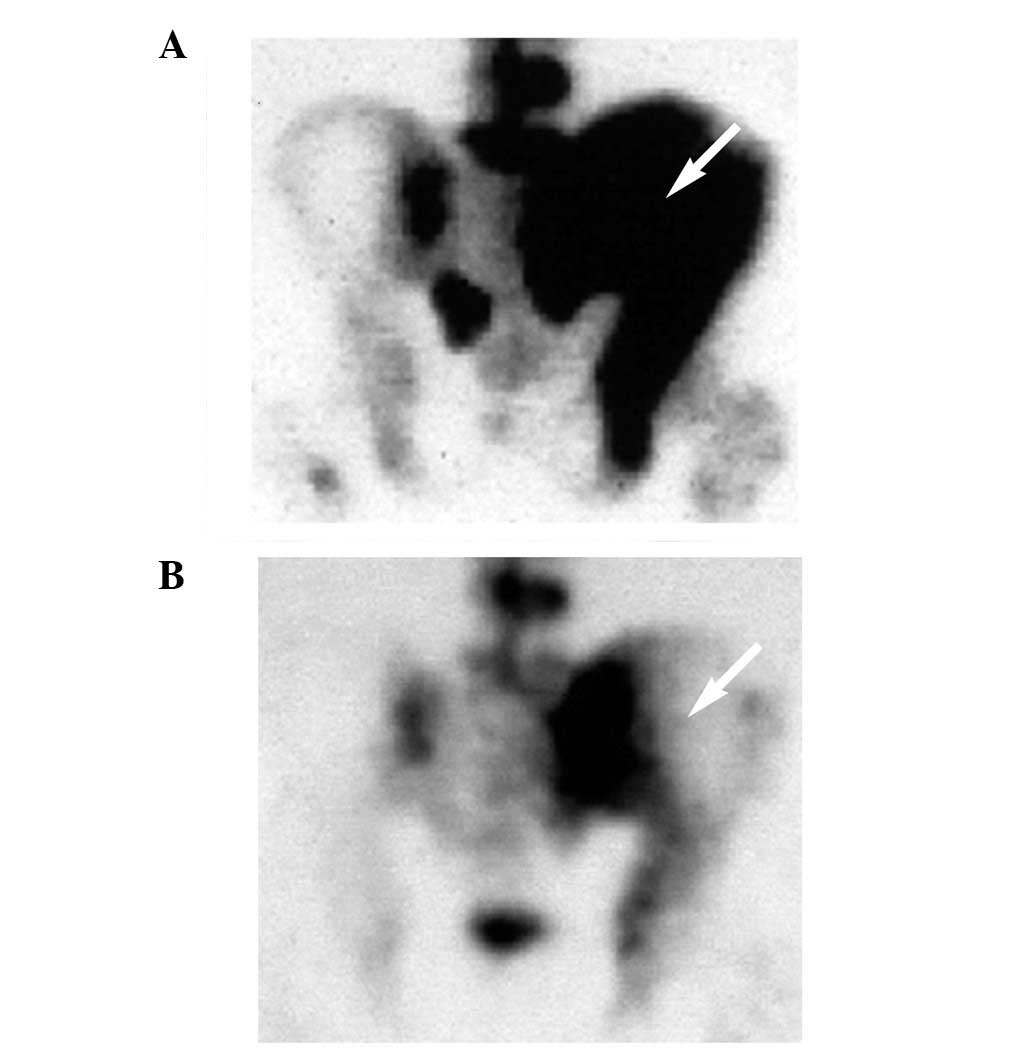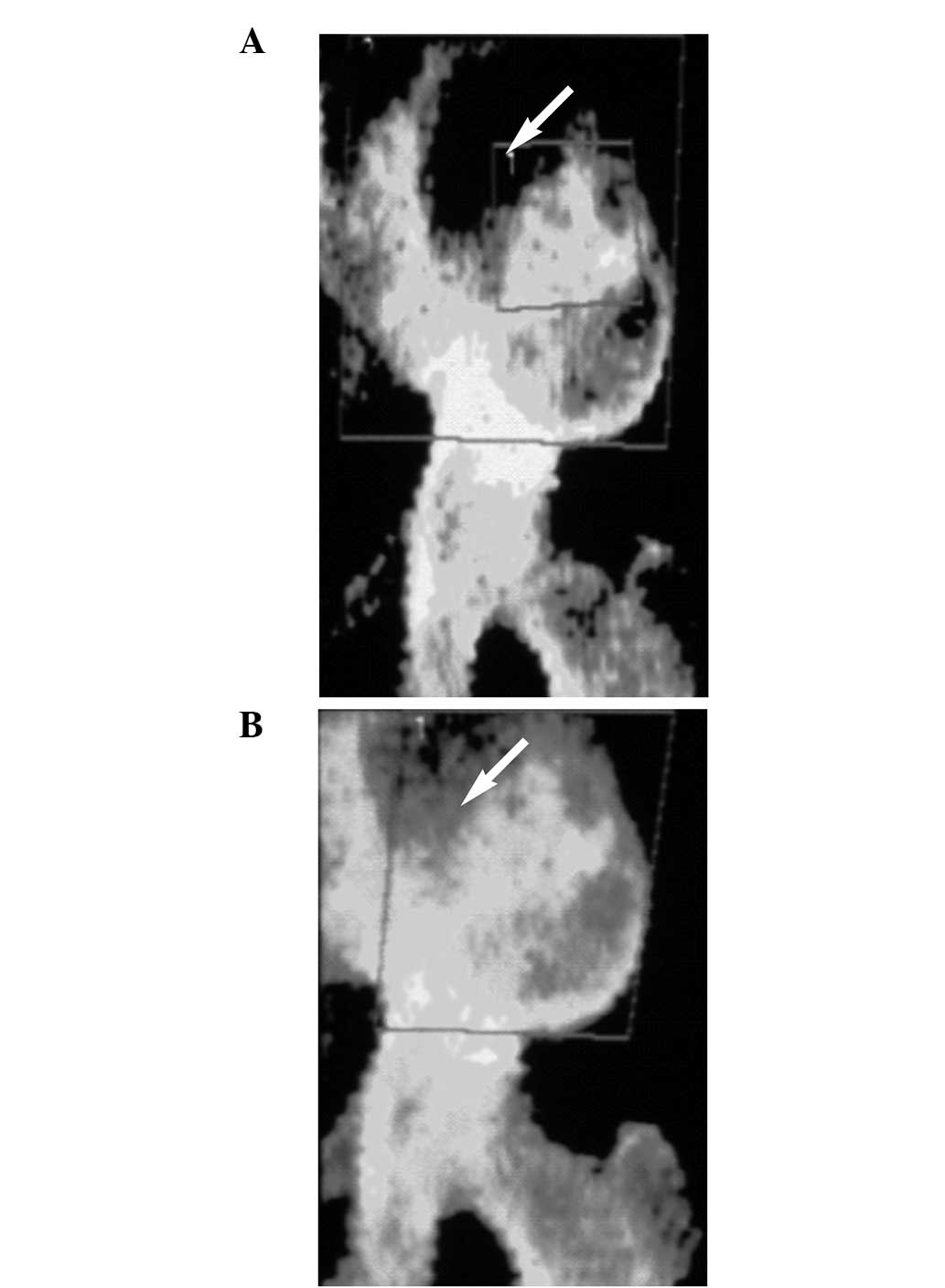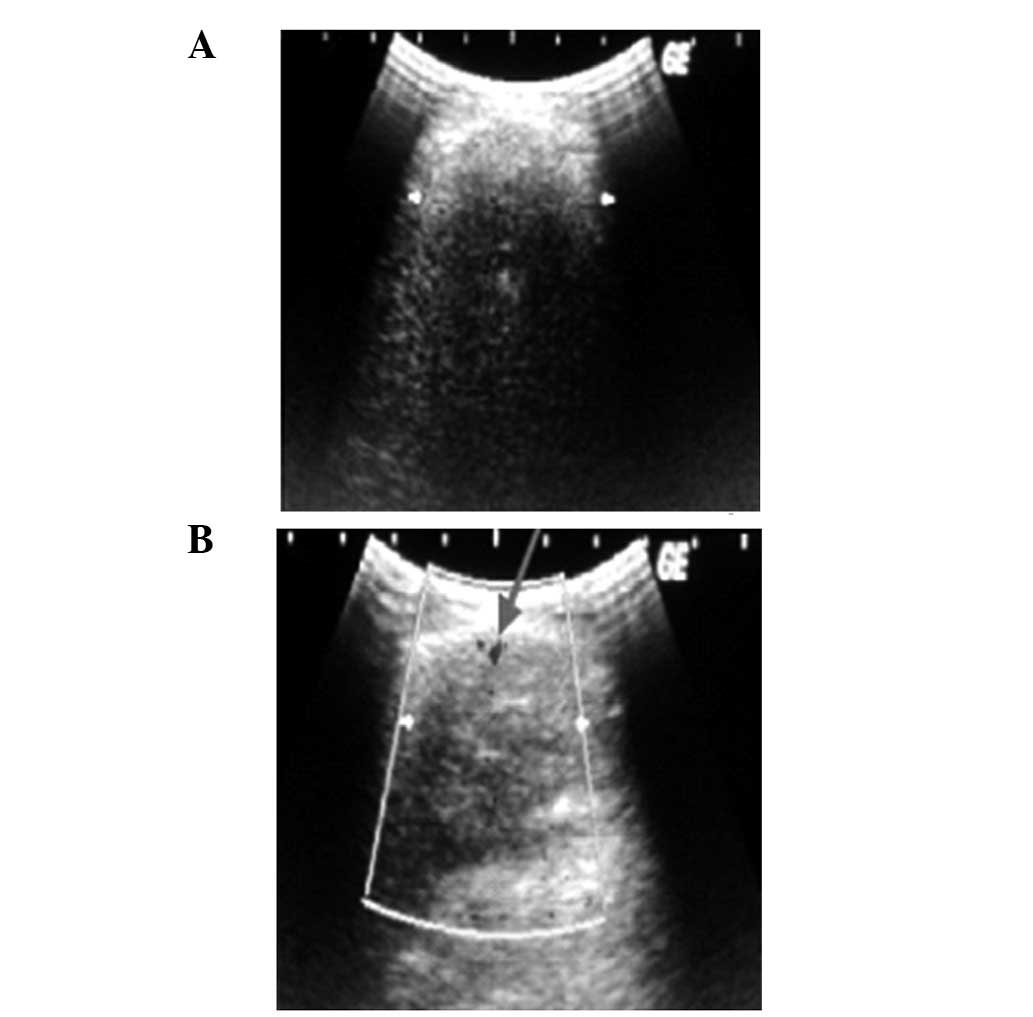Introduction
Prostate cancer is the most common malignancy and
the second leading cause of cancer-associated mortality in males
(1). Bone metastasis of prostate
cancer is frequent and generally manifold and osteoblastic
(2). One of the major
complications associated with bone involvement is severe pain,
which restricts mobility and sleep, greatly reducing performance
status and compromising the patient's quality of life. Conventional
approaches, including external beam radiotherapy or systemic
chemotherapy, are the mainstay of treatment in advanced cancers
(3). However, the identification
of a successful treatment for patients with huge osseous metastases
is difficult. Radiopharmaceuticals are now available for the
palliation of metastatic bone pain (4,5). As
a pure β-emitter, strontium-89 chloride (89Sr) has
similar biological properties to calcium, which has a natural
affinity for metabolically active bone. It localizes in skeletal
tissue primarily at sites of increased osteoblastic activity
(6). In most cases,
89Sr is used for the palliation of painful osseous
metastases. The nuclide also shows great potential in the therapy
for osseous metastases of prostate carcinoma (7–9). The
present study describes the use of 89Sr therapy in a
patient with huge osseous metastases from prostate carcinoma where
a partial response to treatment was obtained.
Case report
A 52-year-old male had previously been diagnosed
with prostate cancer and had been castrated (treated by
orchiectomy). Following surgery, he had not been treated with
external beam radiotherapy or chemotherapy. The patient presented
with severe pain at multiple sites, particularly in the right hip.
In the preceding six months, he had been bedridden due to a
limitation of movement. A 99mTc-methylene diphosphonate
(99mTc-MDP) bone scan showed multiple areas of abnormal
uptake, including L5, S1, the sacroiliac joints, the fourth sacral
vertebra and particularly the right hip, ilium and ischium which
were covered with huge metastatic lesions (Fig. 1A). These corresponded with the
lytic metastases that were evident on the baseline radiography
(Fig. 2A). The patient's quality
of life was noticeably improved following eight consecutive
treatments of 89Sr over 3 years (each dose 4 mCi, total
dose 32 mCi or 1184 MBq). An improvement in mobility was
demonstrated, as evidenced by the fact that he was now able to ride
a bicycle. A comparison between 99mTc-MDP bone images
taken prior to (Fig. 1A) and
post-treatment (Fig. 1B) showed
that the lesions on the left side of the fourth sacral vertebra had
almost disappeared and that the range of the pelvic lesions on the
right side was significantly reduced. The iliac spine was clearly
visible and levels of prostate-specific antigen (PSA) had decreased
by ∼69%. An X-ray revealed that the lesions were in a quiescent
state. Evidence of a new osteosclerotic response at these lytic
lesions was also identified (Fig.
2B). In summary, the extent of the lesions had been
significantly reduced. The bone mineral density (BMD), bone mineral
content (BMC) and total score (Tscore) value of the lesions prior
to (Fig. 3A) and post-treatment
(Fig. 3B) were as follows: BMD,
0.704 and 0.897 g/cm2; BMC, 13.02 and 81.78 g; and
Tscore, −2.15 (62%) and −1.14 (80%), respectively. In comparison
with the ultrasonic imaging results recorded prior to treatment
(Fig. 4A), the results of
ultrasonography post-treatment (Fig.
4B) showed that the previous lesions had become brightly
echogenic and that there was angiogenesis throughout the bone.
Prior to 89Sr therapy, the patient's white blood cell
(WBC) and platelet counts were 5.8 and 109x109/l,
respectively. Following the last 89Sr therapy, his WBC
and platelet counts were 5.8 and 108x109/l,
respectively. In this case, a reduction in leukocyte and
thrombocyte levels was not observed.
The data showed that the patient had a partial
response (PR) to the treatment; not only had the patient's
analgesic requirements decreased by ∼75%, but his Karnofsky
Performance Score (KPS) had also risen by 30%. The patient
exhibited a substantial palliative response to 89Sr
therapy. More meaningfully, the patient had survived for 4 years
with few serious side-effects. The study was approved by the ethics
committee of West China Hospital of Sichuan University, Chengdu,
China. Written informed consent was obtained from the patient
Discussion
Bone metastases are a severe problem in oncology, as
they are usually associated with pain (10). For the majority of patients,
external beam radiotherapy provides excellent palliation for
localized metastatic bone pain. However, when it comes to huge
osseous metastases, particularly on the spine and pelvis, its
therapeutic effect is far from ideal (11,12).
Chemotherapy for huge metastases has not yet been shown to confer
any survival benefit, although its role in the palliation of
osseous metastases is indisputable. The limitation of chemotherapy
for huge metastases is that the dose that may be directed to the
huge bone metastasized sites is low, and increasing the dose or
using multi-drug combination therapy may induce a greater antitumor
response that is less effective. The non-metastatic survival and
overall survival rates are not favorable, mainly due to multi-drug
resistance (13,14).
Systemic radionuclide therapy is an optimal choice
for the management of intractable metastatic bone pain.
89Sr is a bone-seeking radiopharmaceutical used for
internal radiation therapy, with characteristics summarized as
follows: i) it is able to provide pure β particles (electrons) with
a maximum energy of 1.49 MeV, and a mean energy of 0.58 MeV, which
have an apparent tumoricidal effect; ii) the mean range of β
particles in metastatic lesions is short, ∼2.4 mm, and therefore
89Sr is likely to cause only minor radiation damage to
the bone marrow and surrounding tissues; iii) the physical
half-life of 89Sr is 50.5 days, so it may provide
long-lasting relief (6,8,9,15,16).
Following intravenous administration of the usual therapeutic dose
of 4 mCi (148 MBq), 89Sr becomes concentrated in bone in
proportion to osteoblastic activity (17). The uptake of the radiation is ten
times greater in metastatic tumor lesions than in healthy bone.
Clinical studies have shown that irradiation with the β-rays
emitted from the radionuclide in vivo at the site of the
bone tumor, with an absorbed dose of 800 cGy per time, has an
effect on pain relief that is comparable to that of high-dose, long
cycle radiation therapy (6,18).
Based on the physical and metabolic properties of
89Sr, generally following intravenous administration, a
patient's systemic reaction should be mild. In the present study no
significant decrease in hematological variables associated with
89Sr administration was observed. Therefore, from the
evaluation of the imaging results in the present study and the
previously mentioned multi-disciplinary approaches, the conclusion
may be made that 89Sr treatment of huge osseous
metastases in prostate carcinoma has a curative effect and is also
relatively safe.
References
|
1.
|
Heidenreich A, Aus G, Bolla M, et al: EAU
guidelines on prostate cancer. Eur Urol. 53:68–80. 2008. View Article : Google Scholar : PubMed/NCBI
|
|
2.
|
Jacobs SC: Spread of prostatic cancer to
bone. Urology. 21:337–344. 1983. View Article : Google Scholar : PubMed/NCBI
|
|
3.
|
Morris MJ and Scher HI: Clinical
approaches to osseous metastases in prostate cancer. Oncologist.
8:161–173. 2003. View Article : Google Scholar : PubMed/NCBI
|
|
4.
|
Hillegonds DJ, Franklin S, Shelton DK,
Vijayakumar S and Vijayakumar V: The management of painful bone
metastases with an emphasis on radionuclide therapy. J Natl Med
Assoc. 99:785–794. 2007.PubMed/NCBI
|
|
5.
|
Finlay IG, Mason MD and Shelley M:
Radioisotopes for the palliation of metastatic bone cancer: a
systematic review. Lancet Oncol. 6:392–400. 2005. View Article : Google Scholar : PubMed/NCBI
|
|
6.
|
Blake GM, Zivanovic MA, McEwan AJ and
Ackery DM: Sr-89 therapy: strontium kinetics in disseminated
carcinoma of the prostate. Eur J Nucl Med. 12:447–454. 1986.
View Article : Google Scholar : PubMed/NCBI
|
|
7.
|
Giammarile F, Mognetti T and Resche I:
Bone pain palliation with strontium-89 in cancer patients with bone
metastases. Q J Nucl Med. 45:78–83. 2001.PubMed/NCBI
|
|
8.
|
Robinson RG: Strontium-89-precursor
targeted therapy for pain relief of blastic metastatic disease.
Cancer. 72(Suppl S11): 3433–3435. 1993. View Article : Google Scholar : PubMed/NCBI
|
|
9.
|
Dearnaley DP, Bayly RJ, A'Hern RP, Gadd J,
Zivanovic MM and Lewington VJ: Palliation of bone metastases in
prostate cancer. Hemibody irradiation or strontium-89? Clin Oncol
(R Coll Radiol). 4:101–107. 1992. View Article : Google Scholar : PubMed/NCBI
|
|
10.
|
Mercadante S and Fulfaro F: Management of
painful bone metastases. Curr Opin Oncol. 19:308–314. 2007.
View Article : Google Scholar
|
|
11.
|
McQuay HJ, Collins SL, Carroll D and Moore
RA: Radiotherapy for the palliation of painful bone metastases
(Review). Cochrane Database Syst Rev. CD0017932000.
|
|
12.
|
Di Lorenzo G, Autorino R, Ciardiello F, et
al: External beam radiotherapy in bone metastatic prostate cancer:
impact on patients' pain relief and quality of life. Oncol Rep.
10:399–404. 2003.
|
|
13.
|
Polascik TJ: Bisphosphonates in oncology:
evidence for the prevention of skeletal events in patients with
bone metastases. Drug Des Devel Ther. 3:27–40. 2009.PubMed/NCBI
|
|
14.
|
Major P: Optimal management of metastatic
bone disease. Eur J Oncol Nurs. 11(Suppl 2): S32–S37. 2007.
View Article : Google Scholar
|
|
15.
|
Nightengale B, Brune M, Blizzard SP,
Ashley-Johnson M and Slan S: Strontium chloride Sr 89 for treating
pain from metastatic bone disease. Am J Health Syst Pharm.
52:2189–2195. 1995.PubMed/NCBI
|
|
16.
|
Bauman G, Charette M, Reid R and Sathya J:
Radiopharmaceuticals for the palliation of painful bone
metastasis-a systemic review. Radiother Oncol. 75:258–270. 2005.
View Article : Google Scholar : PubMed/NCBI
|
|
17.
|
Li WB, Höllriegl V, Roth P and Oeh U:
Influence of human biokinetics of strontium on internal ingestion
dose of 90Sr and absorbed dose of 89Sr to
organs and metastases. Radiat Environ Biophys. 47:225–239. 2008.
View Article : Google Scholar : PubMed/NCBI
|
|
18.
|
Ben-Josef E, Maughan RL, Vasan S and
Porter AT: A direct measurement of strontium-89 activity in bone
metastases. Nucl Med Commun. 16:452–456. 1995. View Article : Google Scholar : PubMed/NCBI
|


















